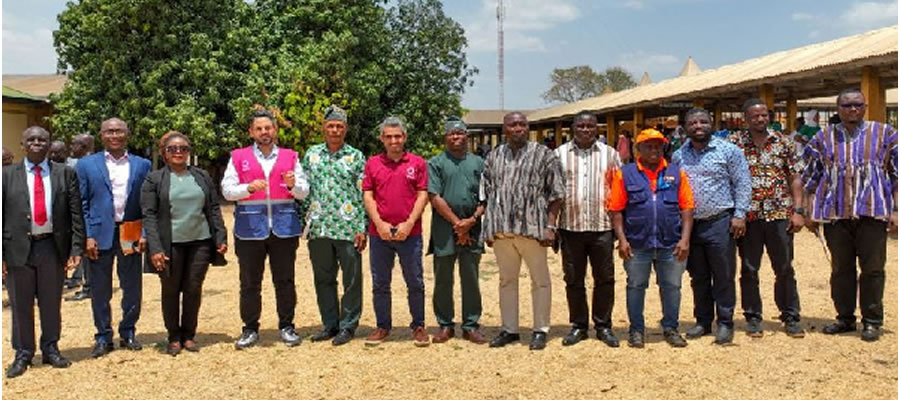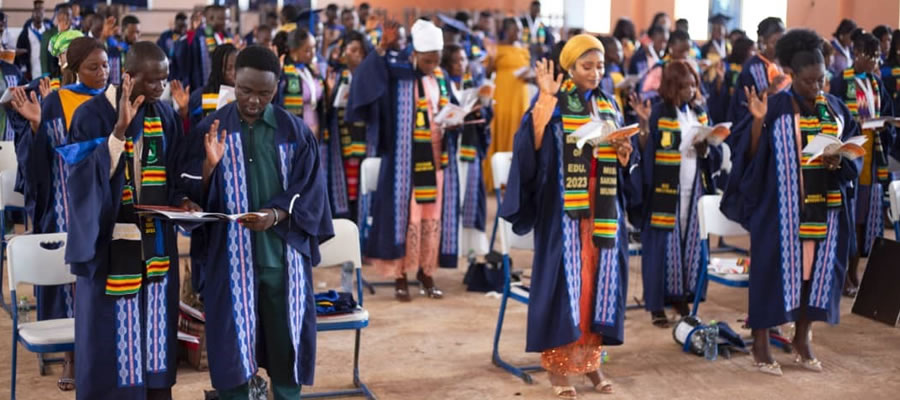

OVERVIEW
The following are analysis of enrolment trends at all Pre-Tertiary levels of education operating in the Municipal Directorate between 2004/05 and 2009/2010, and the participatory rates of females during the period under review.
KINDERGARTEN EDUCATION AND ACCESS TRENDS
The total number of kindergarten (K.G.) schools reporting for 2009/2010 is one hundred and eighteen (118) as against one hundred and eleven (111) the previous year 2008/2009 and one hundred and four (104) in 2007/2008. The percentage increase in K.G. schools for the consecutive years are; 6.3% for 2008/2009 and 2009/2010, and 6.7% for 2007/2008 and 2008/2009. The school expansion rate annually is about 6%.
The enrolment growth rates for the period under review are as follows:
2008/2009 – 2009/2010 18.4% (enrolment from 9,069 to 10,745)
2007/2008 – 2008/2009 13.5% (enrolment from 7,989 to 9,069)
2006/2007 – 2007/2008 71.3% (enrolment from 4,664 to 7,989)
2005/2006 – 2006/2007 14.4% (enrolment from 4,076 to 4,664)
2004/2005 – 2005/2006 37.4% (enrolment from 2,967 to 4,076)
The Gross Enrolment Ratio (GER) increased from 71.65 to 74.2 between 2008/2009 and 2009/2010 and the Gender Parity Index (GPI) declined from 0.82 to 0.81 between 2008/2009 and 2009/2010. Both Female and Male Gross Enrolment Rates increased annually. However, the male Gross Enrolment Ratio is faster than the female Gross Enrolment ratio (FGER) which has lead to the decline in the GPI since 2006 to 2010.
The Directorate has realized that the K.G. schools that have been established are mainly in the Urban and Peri-Urban settlements which have almost all school going age children already in school. When the rural Primary Schools open up K.Gs. the GER will improve drastically and it is hoped that the G.P.I will improve tremendously.
The Pupil teacher ratio (PTR) in the K.G is very high. It is 85.5, which indicate the need for more teachers to be recruited to teach in the K.G. schools. The total number of teachers currently teaching in the K.Gs both Public and in private is 169. So for the Municipal directorate to realize an acceptable PTR of between 25 to 35 it will need at least 304 teachers. So currently there is a short fall of at least 135 teachers in the K.G. Schools.
The quantities of textbook/Teaching and Learning Materials in the K.G schools is nothing to write home about. Apart from a few learning cards that are available in the schools, there is no K.G textbooks for pupils. However, the school to syllabus ratio is 1:1. There is at least one reference book for K.G. teachers in every K.G. school in the Municipal.
PRIMARY EDUCATION AND ACCESS TRENDS
DISTRICT LEVEL ENROLMENT FIGURES AND GROWTH
The total number of Primary Schools, Public and Private, reporting is 166. There are 160 public Primary Schools and 6 Private primary schools.
The changes in enrolment growth rates for both public and private primary schools in Yendi Municipal are as follows:
2008/2009 – 2009/2010 7.05% (enrolment from 27,230 to 29,149)
2007/2008 – 2008/2009 0.03% (enrolment from 27,223 to 27,230)
2006/2007 – 2007/2008 12.1% (enrolment from 24,280 to 27,223)
2005/2006 – 2006/2007 15.2% (enrolment from 21,081 to 24,280)
2004/2005 – 2005/2006 13.1% (enrolment from 18,639 to 21,081)
For 2009/2010 the Gross Enrolment Ratio increased from 93.29% in 2008/2009 to 97.2%. The Female Gross Enrolment Ratio (FGER) increased from 84.47 to 87.8 between 2008/2009 and 2009/2010, with Gender Parity Index (GPI) remaining at 0.83 for the same period. The Gross Admission Ratio (GAR) for 2009/2010 is 161.3 as against 165.0 for 2008/2009. There was a decline in Gross Admission Ratio (GAR) of 3.7 points. Since 2007/2008 GAR has been on the decline. With continuous increase in Primary Class 1 Admission annually, a decline in GAR could be an indication of fewer children of age seven (7) years and above given admissions in P.1. The Female Gross Admission Ratio (FGAR) moved downward from 146.4 to 143.3.
QUALITY TRENDS IN PRIMARY EDUCATION
Generally, the Pupil-Teacher Ratio (P.T.R.) for 2009/2010 in Public schools is 44.6 which is higher than it was the previous year of 36.6. In Private schools t he P.T.R. is 18.
The percentage of Trained Teachers in the Public Schools is 23% and in the Private schools is 0%.
The pupil to core textbook ratio is 1:1 in the Municipality. Out of 160 primary schools, 71 schools have toilet facility and 99 schools have access to portable water. The number of new classrooms needed is 453, and about 420 classrooms need major repairs.
The Municipal Directorate will continue to do community sensitization using role Models and District Support Teams to promote higher female enrolment and improved retention at the Basic level. The Municipal Assembly will also put in place teachers’ incentive packages to attract more trained teachers into the District and to retain those teachers who are already in the Municipal.
JUNIOR HIGH SCHOOL ENROLMENT AND ACCESS TREND
DISTRICT LEVEL ENROLMENT FIGURES AND GROWTH RATES
In 2009/2010 the total number of Junior High Schools reporting is 30 as it was in the previous year. All the 30 schools are public schools.
The following are the enrolment growth rates:
2008/09 – 2009/2010 5.07% (enrolment from 6,430 to 6,756)
2007/08 – 2008/09 14.92% (enrolment from 5,595 to 6,430)
2006/07 – 2007/08 7.3% (enrolment from 5,214 to 5,595)
2005/06 – 2006/07 8.2% (enrolment from 4,820 to 5,215)
2004/05 – 2005/06 13.0% (enrolment from 4,269 to 4,820)
The Gross Enrolment Ratio (GER) for 2009/2010 is recorded as 75.4% which is 1.6% higher than the 2008/09 GER of 73.8%. The Female Gross Enrolment Ratio (FGER) for the year of reporting is 62.4% as compared to 59.5% for 2008/09, and the G.P.I. stands at 0.8.
Generally the enrolment increased for both sexes at about the same rate. The enrolment increase is as a result of a fall in the drop out at the transition stage, from Primary school to Junior High School. The Directorate continues to carry out community sensitization on enrolment and retention, particularly in the remote communities.
The Gross Admission Ratio (GAR) for 2009/2010 is about 88% as against 90.3% in 2008/09. Considering computational errors, the average Gross Admission ratio for the past three years is about 89%. The Female Gross Admission Ratio (FGAR) is about 82%.
For the year 2009/2010 the Pupil Teacher Ratio (PTR) in the Public Schools is 28 and for the year 2008/2009 it was 26.5. The increase in the PTR is as a result of both teacher attrition and increase in enrolment. An immediate solution to the high PTR is that some Pupil Teachers should be recruited as a short term measure, and in the long run the Assembly would be encouraged to sponsor more Teacher Trainees. It will also be encouraged to motivate teachers to stay longer in the Municipality.
The Pupil to core textbook ratio is 1:1. There are sufficient copies of the core textbooks in the Municipality.
There are 242 teachers teaching in the Junior High Schools in the Municipality. Of this number 168 are trained, thus the percentage of trained teachers in the Junior High Schools is about 69.4. Last year, 2008/2009, the percentage of trained teachers was 73.7. There was a higher number of trained teachers last year than this year, 2009/2010. This is as a result of many more trained teachers leaving the Municipality either to pursue further studies or on transfers to other districts.
To check the phenomenon of high teachers’ attrition rate, the Directorate has put in place measures to ensure that only teachers, who qualify for study leave, leave the Municipality. Also the Municipality will be made more attractive for teachers who want to stay for longer period of time. This will be a collaborative act between the Municipal Directorate and the Yendi Municipal Assembly and NGOs.
SENIOR HIGH SCHOOL ENROLMENT AND ACCESS TRENDS
There are two Senior High Schools in the Municipality. One school is Secondary/Technical Day School and the other is Secondary Boarding School. They are both mixed sexes and they are public schools.
The Enrolment Growth Rates of the Senior High Schools are as follows:
2008/09 – 2009/2010 16.5%% (enrolment from 2121 to 2471)
2007/08 – 2008/09 4.6% (enrolment from 2027 to 2121)
2006/07 – 2007/08 11.3% (enrolment from 1822 to 2027)
2005/06 – 2006/07 3.8% (enrolment from 1755 to 1822)
2004/05 – 2005/06 2.8% (enrolment from 1711 to 1755)
The percentage Female Growth Rates are as follows:
2008/09 – 2009/2010 32.9% (enrolment from 578 to 768)
2007/08 – 2008/09 13.1% (enrolment from 511 to 578)
2006/07 – 2007/08 18.0% (enrolment from 433 to 511)
2005/06 – 2006/07 2.0% (enrolment from 442 to 433)
2004/05 – 2005/06 5.2% (enrolment from 420 to 442)
The Female enrolment rate of 32.9% for 2008/2009 – 2009/2010 is relatively higher than any of the previous four years, and the Gender Parity Index is 0.45.
Date Created : 11/27/2017 4:47:17 AM











 facebook
facebook
 twitter
twitter
 Youtube
Youtube
 +233 593 831 280
+233 593 831 280 0800 430 430
0800 430 430 GPS: GE-231-4383
GPS: GE-231-4383 info@ghanadistricts.com
info@ghanadistricts.com Box GP1044, Accra, Ghana
Box GP1044, Accra, Ghana